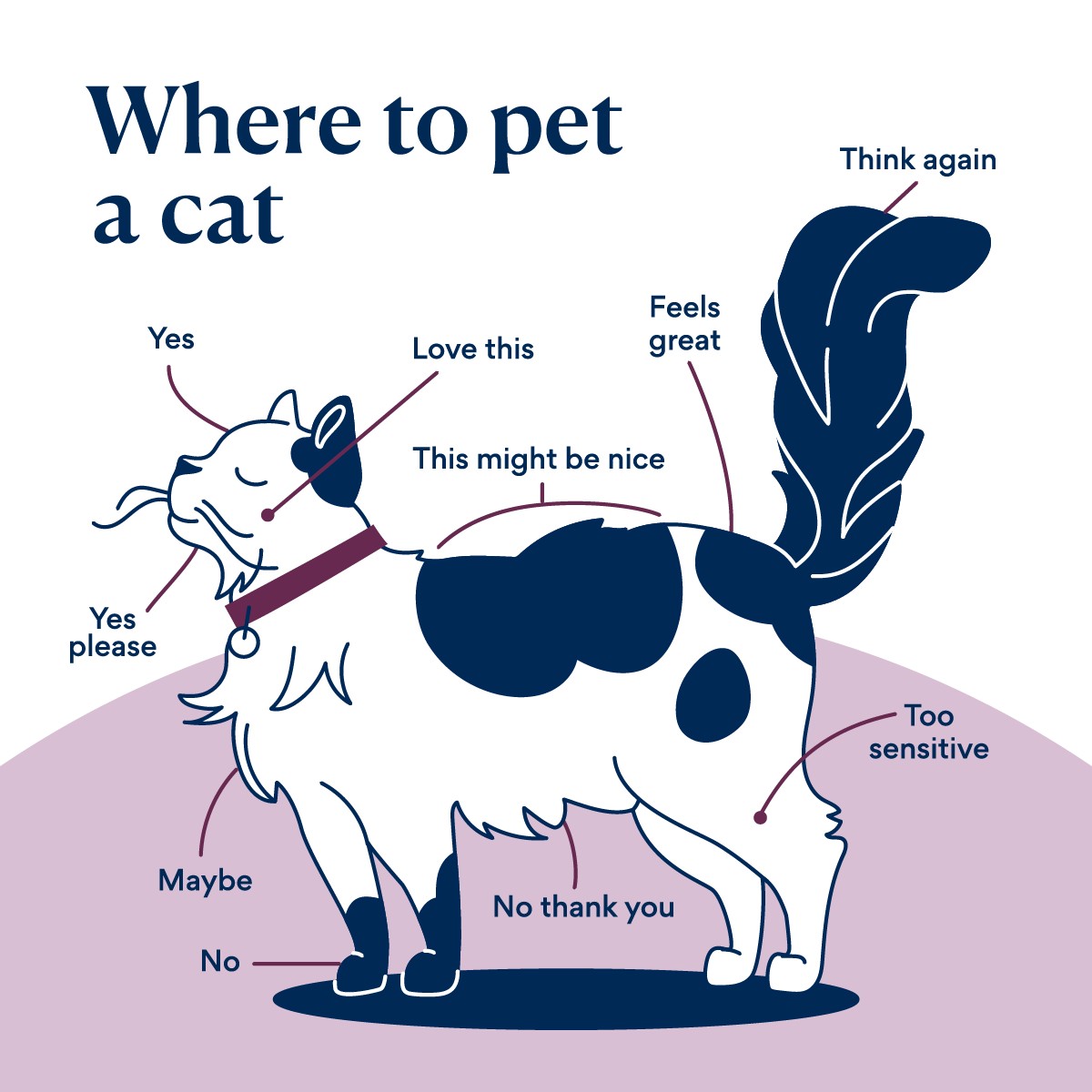Where Pet Cats like to be pet the most is a question many cat owners ponder. At PETS.EDU.VN, we provide insights into feline behavior to help you build a stronger bond with your cat. Understanding the preferred petting zones and avoiding sensitive areas can enhance your cat’s well-being and deepen your relationship, leading to a happier, healthier pet. Learn about feline affection, petting preferences, and cat behavior.
1. Understanding Your Cat’s Petting Preferences
Do cats like to be pet? Absolutely, but understanding where they like to be pet is key. Cats are complex creatures with individual preferences, and knowing these preferences can significantly improve your interactions with them.
1.1. Decoding Feline Body Language
How do you tell if a cat wants to be pet? Cats communicate their desires through body language. Recognizing these signals is essential for a positive interaction.
- Approaching You: A cat approaching you with a relaxed posture often indicates they’re open to interaction.
- Upright Tail: A tail held high with a slight curl at the end is usually a sign of happiness and an invitation for petting.
- Rubbing: When a cat rubs against your legs or hand, they’re marking you with their scent and seeking attention.
- Ears Forward: Ears facing forward and upright suggest the cat is relaxed and receptive to petting.
- Loose Body Posture: A relaxed, non-rigid posture indicates the cat is comfortable and at ease.
1.2. Recognizing Discomfort Signals
What are the signs that a cat doesn’t want to be pet? It’s crucial to recognize signs of discomfort to avoid negative interactions.
- Avoiding Contact: If a cat moves away or hides when you approach, they likely don’t want to be pet at that moment.
- Rigid Posture: A tense, stiff body indicates the cat is feeling uneasy.
- Flattened Ears: Ears pinned back against the head signal fear or aggression.
- Dilated Pupils: Enlarged pupils, especially in bright light, can indicate fear or stress.
- Swishing Tail: A tail swishing back and forth rapidly often means the cat is irritated or agitated.
- Growling or Hissing: These are clear warnings that the cat is feeling threatened and needs space.
 Cat body language indicating happiness and relaxation
Cat body language indicating happiness and relaxation
2. The Best Places to Pet Your Cat
Where are the most enjoyable spots to pet a cat? Understanding the ideal petting zones can enhance your cat’s comfort and strengthen your bond.
2.1. Chin and Cheeks
Why do cats love being pet on their chin and cheeks? These areas are rich in scent glands, and petting here allows cats to mark you with their pheromones, reinforcing social bonds.
- Scent Glands: Cats have scent glands on their chin and cheeks, which they use to mark their territory and create a sense of familiarity.
- Social Bonding: When you pet these areas, you’re essentially participating in a social grooming behavior, similar to how cats groom each other.
- Relaxation: Gentle strokes in these areas can be very soothing and relaxing for cats.
2.2. Forehead
Is petting a cat’s forehead a good idea? For many cats, the forehead is a welcome petting zone, especially among familiar individuals.
- Scent Marking: Like the chin and cheeks, the forehead also contains scent glands.
- Comfort: Many cats enjoy the sensation of gentle scratching or rubbing on their forehead.
- Trust: Allowing you to touch their forehead signifies trust and comfort with your presence.
2.3. Base of the Tail
Why do cats enjoy being pet at the base of their tail? This area can be particularly pleasurable, but it’s crucial to observe your cat’s reaction to avoid overstimulation.
- Nerve Endings: The base of the tail has many nerve endings, which can make petting very enjoyable for some cats.
- Overstimulation: Be cautious, as prolonged petting in this area can lead to overstimulation and potential aggression.
- Individual Preference: Some cats love it, while others may not, so pay attention to your cat’s body language.
2.4. Back
Do cats like being pet on their back? Yes, gentle strokes along the back can be very pleasant for most cats.
- Comfort and Relaxation: Gentle petting along the back mimics grooming behavior, providing comfort and relaxation.
- Avoiding Overstimulation: Long, continuous strokes can sometimes lead to overstimulation, so watch for signs of discomfort.
- Muscle Relaxation: Petting can help relax the muscles along the back, providing relief from tension.
3. Areas to Avoid When Petting a Cat
Where should you avoid petting a cat? Knowing the no-go zones can prevent discomfort and potential aggression.
3.1. Stomach
Why do cats dislike being pet on their stomach? The stomach is a vulnerable area, and most cats are protective of it.
- Vulnerability: The stomach is a soft, unprotected area, making cats feel exposed and vulnerable.
- Instinct: Cats instinctively protect their vital organs, and being touched on the stomach can trigger a defensive response.
- Trust: Only cats who have a very high level of trust may allow you to touch their stomach, and even then, it should be done gently and briefly.
3.2. Paws
Do cats enjoy having their paws touched? Generally, no. Most cats are sensitive about their paws and dislike being touched there.
- Sensitivity: Paws are highly sensitive due to the many nerve endings, and touching them can be uncomfortable.
- Control: Cats like to have control over their paws, and being touched there can make them feel restricted.
- Grooming: Cats typically groom their own paws and don’t need assistance from humans.
3.3. Legs
Why do cats often dislike being pet on their legs? Legs are another sensitive area that most cats prefer to keep to themselves.
- Balance: Cats rely on their legs for balance, and being touched there can make them feel unstable.
- Personal Space: Like paws, legs are part of a cat’s personal space and are not always open to interaction.
- Potential Injury: Cats may associate leg touches with potential injury, leading to a negative response.
3.4. Tail
Is it okay to pet a cat’s tail? Most cats do not enjoy having their tail touched or petted.
- Sensitivity: The tail is an extension of the spine and is very sensitive.
- Control: Cats use their tail for balance and communication, and being touched there can feel intrusive.
- Potential Irritation: Some cats may become irritated or aggressive if their tail is touched.
4. Creating a Positive Petting Experience
How can you ensure petting sessions are enjoyable for both you and your cat? Creating a positive environment and paying attention to your cat’s signals are crucial.
4.1. Approaching Gently
How should you approach a cat you want to pet? Always approach slowly and calmly, allowing the cat to initiate contact.
- Slow Movements: Avoid sudden or quick movements that can startle the cat.
- Quiet Voice: Speak in a soft, soothing voice to reassure the cat.
- Eye Contact: Maintain soft, gentle eye contact to show you are not a threat.
4.2. Letting the Cat Initiate
Why is it important to let the cat initiate petting? Allowing the cat to come to you ensures they are comfortable and willing to interact.
- Control: Giving the cat control over the interaction reduces stress and anxiety.
- Trust: Allowing the cat to approach builds trust and strengthens your bond.
- Positive Association: By letting the cat initiate, you create a positive association with petting.
4.3. Monitoring Body Language
How can you tell if a cat is enjoying being pet? Pay close attention to their body language for signs of pleasure or discomfort.
- Purring: A soft, contented purr is a good sign that the cat is enjoying the petting.
- Relaxed Posture: A loose, relaxed body posture indicates comfort and contentment.
- Rubbing: If the cat continues to rub against you, they are likely enjoying the attention.
- Ears Forward: Ears facing forward and upright suggest the cat is relaxed and receptive.
- Slow Blinking: Slow blinking is a sign of trust and affection.
4.4. Avoiding Overstimulation
What is overstimulation, and how can you prevent it? Overstimulation occurs when a cat becomes overwhelmed by petting, leading to discomfort or aggression.
- Signs of Overstimulation: Watch for signs like tail twitching, skin rippling, flattened ears, or sudden biting.
- Short Sessions: Keep petting sessions short and sweet to avoid overwhelming the cat.
- Varying Petting Location: Change where you are petting the cat to prevent overstimulation in one area.
5. Understanding Individual Cat Preferences
Why do some cats like different petting styles than others? Just like humans, cats have unique personalities and preferences.
5.1. Personality Differences
How does a cat’s personality affect their petting preferences? A cat’s personality plays a significant role in what they enjoy and tolerate.
- Outgoing Cats: More outgoing cats may be more receptive to petting and interaction.
- Shy Cats: Shy or timid cats may prefer shorter, less intense petting sessions.
- Independent Cats: Independent cats may only tolerate petting on their own terms.
5.2. Breed Variations
Are there breed-specific petting preferences? While individual personalities are more important, some breeds may be generally more affectionate than others.
- Siamese: Known for being very social and affectionate.
- Persian: Typically enjoy gentle, calm petting sessions.
- Ragdoll: Often described as “puppy-like” and enjoy being held and petted.
5.3. Past Experiences
How can a cat’s past experiences influence their petting preferences? Past experiences, especially negative ones, can shape a cat’s behavior and comfort levels.
- Trauma: Cats who have experienced trauma may be more sensitive to touch and less trusting.
- Positive Reinforcement: Cats who have had positive experiences with petting are more likely to enjoy it.
- Consistency: Consistent, gentle interactions can help build trust and overcome negative associations.
6. Health and Petting
Can petting reveal health issues in cats? Yes, regular petting sessions can help you notice changes in your cat’s body that may indicate a health problem.
6.1. Checking for Lumps and Bumps
How can petting help you detect abnormalities? While petting your cat, you can feel for any unusual lumps, bumps, or sensitive areas.
- Regular Examination: Make petting a regular opportunity to check your cat’s body for changes.
- Early Detection: Early detection of lumps or bumps can lead to prompt veterinary care.
- Consult a Vet: If you find anything concerning, consult your veterinarian.
**6.2. Identifying Sensitive Areas
Why is it important to notice if a cat flinches during petting? Sensitivity to touch in certain areas can indicate pain or discomfort.
- Arthritis: Painful joints may cause a cat to flinch when touched in those areas.
- Skin Issues: Skin infections or allergies can make the skin sensitive to touch.
- Internal Problems: Pain in the abdomen can make the cat reluctant to be touched on the stomach.
6.3. Monitoring Coat Condition
How can petting help you assess your cat’s coat health? The condition of your cat’s coat can be an indicator of their overall health.
- Dry or Matted Fur: Can indicate dehydration or poor grooming habits, potentially due to illness.
- Hair Loss: Excessive shedding or bald spots can be a sign of allergies, stress, or skin infections.
- Parasites: Fleas or ticks can be detected during petting sessions.
7. Cat Petting Techniques
What are some techniques for petting a cat? Here are some techniques that can ensure that petting is a positive experience for your furry friend.
7.1. The Gentle Stroke
How should you perform a gentle stroke on a cat? Gentle strokes are a great way to bond with your cat.
- Use Your Fingers: Gently use your fingers to stroke the cat’s fur, rather than your whole hand.
- Follow Fur Direction: Always stroke in the direction that the fur grows.
- Start with Chin: Start by petting them under the chin.
7.2. The Soft Scratch
Where is the best place to give a cat a soft scratch? A soft scratch can be very comforting for your cat.
- Behind the Ears: Gently scratch behind the ears.
- Under the Chin: Scratch lightly under the chin.
- Use Light Pressure: Be careful to use light pressure.
7.3. The Slow Approach
Why is approaching slowly important when petting a cat? The slow approach allows the cat to become comfortable and feel more in control.
- Let Them Sniff: Let the cat sniff your hand first.
- Avoid Eye Contact: Try to avoid direct eye contact, which can be intimidating.
- Use a Calm Voice: Speak in a calm, soothing voice.
8. Common Petting Mistakes
What mistakes should you avoid when petting a cat? Being aware of the common petting mistakes can prevent negative interactions.
8.1. Being Too Forceful
Why should you avoid being forceful when petting a cat? Forcing affection can create a negative experience for your cat.
- Let Them Come To You: Let the cat come to you, don’t force it.
- Respect Their Space: Respect their personal space.
- Gentle Touch: Always use a gentle touch.
8.2. Ignoring Body Language
How important is it to pay attention to a cat’s body language? It is very important to pay attention to a cat’s body language.
- Watch for Signs: Watch for signs like a twitching tail or flattened ears.
- Stop if Uncomfortable: Stop petting if the cat shows signs of discomfort.
- Avoid Stress: Avoid causing the cat stress.
8.3. Petting the Wrong Areas
What areas should you avoid petting on a cat? Avoid sensitive areas and areas that the cat clearly doesn’t like to be touched.
- Belly: Avoid petting the belly.
- Paws: Avoid touching the paws.
- Tail: Avoid touching or petting the tail.
9. Resources and Further Reading
Where can you find more information about cat behavior and petting? Many resources are available to deepen your understanding of feline behavior.
9.1. Veterinarian Consultations
Why should you consult with a veterinarian about your cat’s behavior? Veterinarians can provide valuable insights into your cat’s health and behavior.
- Expert Advice: Get expert advice on your cat’s specific needs.
- Health Issues: Rule out any underlying health issues.
- Behavioral Problems: Address any behavioral problems.
9.2. Books and Articles
What are some recommended books and articles about cat behavior? Reading books and articles can provide a wealth of information.
- Cat Behavior Books: Many excellent books are available on cat behavior.
- Online Articles: Online articles can provide useful tips and information.
- Reliable Sources: Always ensure you are reading information from reliable sources.
9.3. Online Communities
What are the benefits of joining online cat communities? Online communities can provide support and shared experiences.
- Shared Experiences: Connect with other cat owners and share experiences.
- Tips and Advice: Get tips and advice from other cat lovers.
- Support: Find support and encouragement.
10. Frequently Asked Questions (FAQs) About Cat Petting
10.1. Why Does My Cat Bite Me When I Pet Her?
If your cat bites you when you pet her, it could be due to overstimulation. Stop petting immediately when you notice signs like tail twitching or flattened ears.
10.2. How Can I Tell If My Cat Enjoys Being Pet?
Signs that your cat enjoys being pet include purring, relaxed posture, rubbing against you, and ears facing forward.
10.3. Is It Okay to Pet My Cat While She’s Sleeping?
It’s generally best to avoid petting your cat while she’s sleeping, as it can startle her and disrupt her rest.
10.4. What Should I Do If My Cat Hisses At Me When I Try To Pet Her?
If your cat hisses at you, stop immediately and give her space. Hissing is a clear sign that she’s feeling threatened or uncomfortable.
10.5. Why Does My Cat Only Like Being Pet In Certain Spots?
Cats have individual preferences for where they like to be pet, often related to scent glands and nerve endings. Respect your cat’s preferences and focus on those areas.
10.6. Can Petting Help Reduce My Cat’s Stress?
Yes, gentle petting can help reduce your cat’s stress by releasing endorphins and promoting relaxation.
10.7. How Often Should I Pet My Cat?
Pet your cat as often as she enjoys it, but always respect her boundaries and watch for signs of discomfort.
10.8. What Is the Best Way to Introduce Petting to a New Cat?
Introduce petting slowly and gently, allowing the cat to approach you and initiate contact. Use a soft voice and avoid sudden movements.
10.9. Why Does My Cat Roll Over When I Try To Pet Her?
Rolling over can be a sign of trust and vulnerability, but it doesn’t always mean your cat wants a belly rub. Observe her body language to see if she’s inviting you to pet her belly or simply showing affection.
10.10. Is It Normal for My Cat to Suddenly Stop Liking Petting?
Changes in petting preferences can be due to various factors, including health issues, stress, or changes in the environment. Consult your veterinarian if you notice a sudden change in your cat’s behavior.
Understanding where pet cats like to be pet is vital for building a strong, loving relationship with your feline friend. By paying attention to their body language and respecting their preferences, you can create positive and enjoyable interactions that enhance their well-being and deepen your bond.
Do you have more questions about your cat’s behavior? Visit pets.edu.vn for more expert tips and advice on cat care and training! Contact us at 789 Paw Lane, Petville, CA 91234, United States. Whatsapp: +1 555-987-6543. We are here to help you provide the best possible life for your beloved cat.

